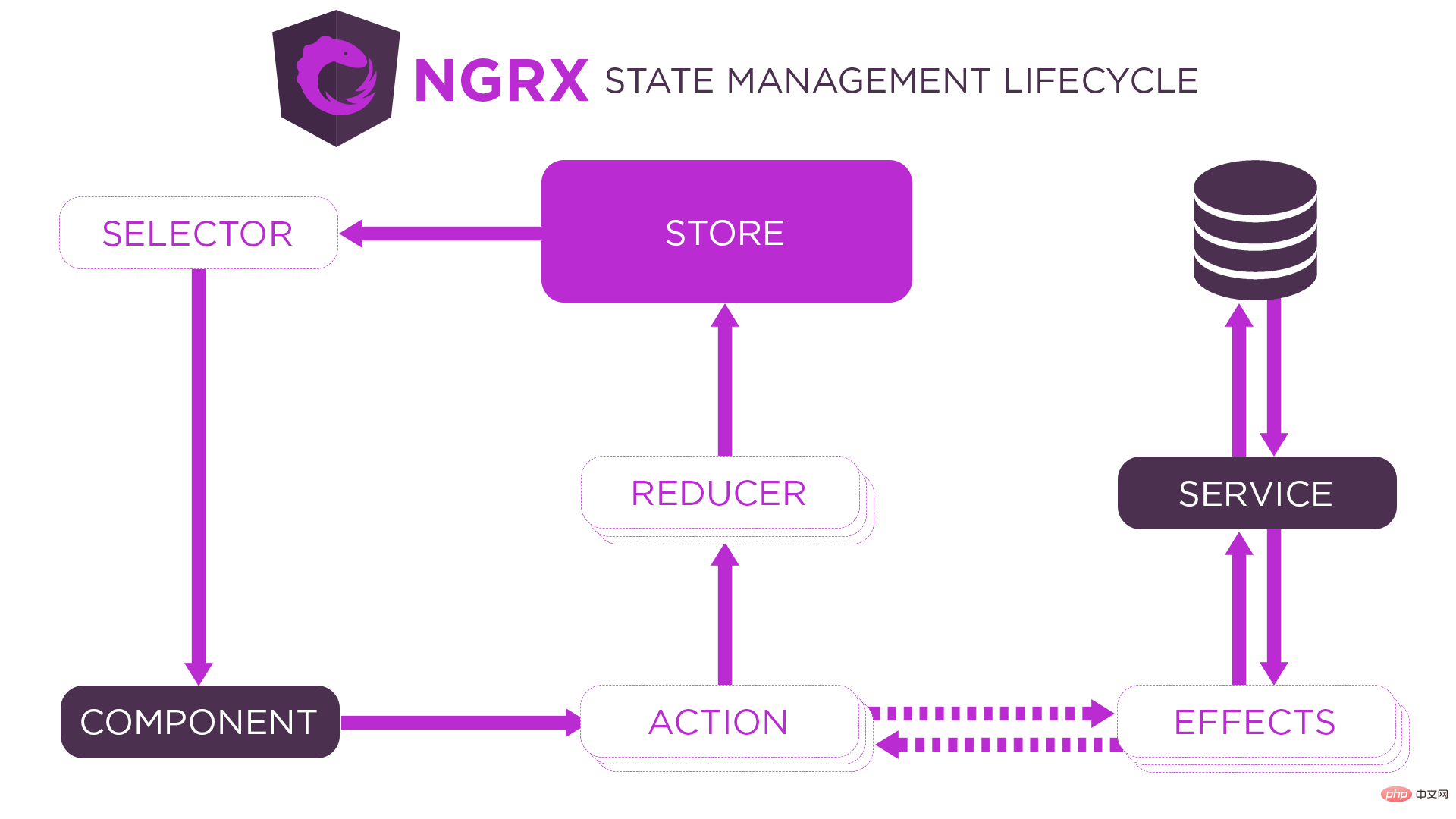本篇文章带大家深入了解一下angular的状态管理器NgRx,介绍一下NgRx的使用方法,希望对大家有所帮助! NgRx 是 Angular 应用中实现全局状态管理的 Redux 架构解决方案。【相关教程推荐:《angular教程》】 @ngrx/store:全局状态管理模块 @ngrx/effects:处理副作用 @ngrx/store-devtools:浏览器调试工具,需要依赖 Redux Devtools Extension @ngrx/schematics:命令行工具,快速生成 NgRx 文件 @ngrx/entity:提高开发者在 Reducer 中操作数据的效率 @ngrx/router-store:将路由状态同步到全局 Store 1、下载 NgRx 2、配置 NgRx CLI 3、创建 Store 4、创建 Action 5、创建 Reducer 6、创建 Selector 7、组件类触发 Action、获取状态 8、组件模板显示状态 1、在组件中使用 dispatch 触发 Action 时传递参数,参数最终会被放置在 Action 对象中。 2、在创建 Action Creator 函数时,获取参数并指定参数类型。 3、在 Reducer 中通过 Action 对象获取参数。 metaReducer 是 Action -> Reducer 之间的钩子,允许开发者对 Action 进行预处理 (在普通 Reducer 函数调用之前调用)。 需求:在页面中新增一个按钮,点击按钮后延迟一秒让数值增加。 1、在组件模板中新增一个用于异步数值增加的按钮,按钮被点击后执行 2、在组件类中新增 3、在 Action 文件中新增执行异步操作的 Action 4、创建 Effect,接收 Action 并执行副作用,继续触发 Action Effect 功能由 @ngrx/effects 模块提供,所以在根模块中需要导入相关的模块依赖 1、概述 Entity 译为实体,实体就是集合中的一条数据。 NgRx 中提供了实体适配器对象,在实体适配器对象下面提供了各种操作集合中实体的方法,目的就是提高开发者操作实体的效率。 2、核心 1、EntityState:实体类型接口 2、createEntityAdapter: 创建实体适配器对象 3、EntityAdapter:实体适配器对象类型接口 3、实例方法 https://ngrx.io/guide/entity/adapter#adapter-collection-methods 4、选择器 1、同步路由状态 1)引入模块 2)将路由状态集成到 Store 2、创建获取路由状态的 Selector

快速开始
npm install @ngrx/store @ngrx/effects @ngrx/entity @ngrx/router-store @ngrx/store-devtools @ngrx/schematicsng config cli.defaultCollection @ngrx/schematics// angular.json
"cli": {
"defaultCollection": "@ngrx/schematics"
}ng g store State --root --module app.module.ts --statePath store --stateInterface AppStateng g action store/actions/counter --skipTestsimport { createAction } from "@ngrx/store"
export const increment = createAction("increment")
export const decrement = createAction("decrement")ng g reducer store/reducers/counter --skipTests --reducers=../index.tsimport { createReducer, on } from "@ngrx/store"
import { decrement, increment } from "../actions/counter.actions"
export const counterFeatureKey = "counter"
export interface State {
count: number
}
export const initialState: State = {
count: 0
}
export const reducer = createReducer(
initialState,
on(increment, state => ({ count: state.count + 1 })),
on(decrement, state => ({ count: state.count - 1 }))
)ng g selector store/selectors/counter --skipTestsimport { createFeatureSelector, createSelector } from "@ngrx/store"
import { counterFeatureKey, State } from "../reducers/counter.reducer"
import { AppState } from ".."
export const selectCounter = createFeatureSelector<AppState, State>(counterFeatureKey)
export const selectCount = createSelector(selectCounter, state => state.count)import { select, Store } from "@ngrx/store"
import { Observable } from "rxjs"
import { AppState } from "./store"
import { decrement, increment } from "./store/actions/counter.actions"
import { selectCount } from "./store/selectors/counter.selectors"
export class AppComponent {
count: Observable<number>
constructor(private store: Store<AppState>) {
this.count = this.store.pipe(select(selectCount))
}
increment() {
this.store.dispatch(increment())
}
decrement() {
this.store.dispatch(decrement())
}
}<button (click)="increment()">+</button>
<span>{{ count | async }}</span>
<button (click)="decrement()">-</button>Action Payload
this.store.dispatch(increment({ count: 5 }))import { createAction, props } from "@ngrx/store"
export const increment = createAction("increment", props<{ count: number }>())export declare function props<P extends object>(): Props<P>;
export const reducer = createReducer(
initialState,
on(increment, (state, action) => ({ count: state.count + action.count }))
)MetaReducer
function debug(reducer: ActionReducer<any>): ActionReducer<any> {
return function (state, action) {
return reducer(state, action)
}
}
export const metaReducers: MetaReducer<AppState>[] = !environment.production
? [debug]
: []Effect
increment_async 方法<button (click)="increment_async()">async</button>
increment_async 方法,并在方法中触发执行异步操作的 Actionincrement_async() {
this.store.dispatch(increment_async())
}export const increment_async = createAction("increment_async")ng g effect store/effects/counter --root --module app.module.ts --skipTestsimport { Injectable } from "@angular/core"
import { Actions, createEffect, ofType } from "@ngrx/effects"
import { increment, increment_async } from "../actions/counter.actions"
import { mergeMap, map } from "rxjs/operators"
import { timer } from "rxjs"
// createEffect
// 用于创建 Effect, Effect 用于执行副作用.
// 调用方法时传递回调函数, 回调函数中返回 Observable 对象, 对象中要发出副作用执行完成后要触发的 Action 对象
// 回调函数的返回值在 createEffect 方法内部被继续返回, 最终返回值被存储在了 Effect 类的属性中
// NgRx 在实例化 Effect 类后, 会订阅 Effect 类属性, 当副作用执行完成后它会获取到要触发的 Action 对象并触发这个 Action
// Actions
// 当组件触发 Action 时, Effect 需要通过 Actions 服务接收 Action, 所以在 Effect 类中通过 constructor 构造函数参数的方式将 Actions 服务类的实例对象注入到 Effect 类中
// Actions 服务类的实例对象为 Observable 对象, 当有 Action 被触发时, Action 对象本身会作为数据流被发出
// ofType
// 对目标 Action 对象进行过滤.
// 参数为目标 Action 的 Action Creator 函数
// 如果未过滤出目标 Action 对象, 本次不会继续发送数据流
// 如果过滤出目标 Action 对象, 会将 Action 对象作为数据流继续发出
@Injectable()
export class CounterEffects {
constructor(private actions: Actions) {
// this.loadCount.subscribe(console.log)
}
loadCount = createEffect(() => {
return this.actions.pipe(
ofType(increment_async),
mergeMap(() => timer(1000).pipe(map(() => increment({ count: 10 }))))
)
})
}Entity
/*
{
ids: [1, 2],
entities: {
1: { id: 1, title: "Hello Angular" },
2: { id: 2, title: "Hello NgRx" }
}
}
*/
export interface State extends EntityState<Todo> {}export const adapter: EntityAdapter<Todo> = createEntityAdapter<Todo>()
// 获取初始状态 可以传递对象参数 也可以不传
// {ids: [], entities: {}}
export const initialState: State = adapter.getInitialState()// selectTotal 获取数据条数
// selectAll 获取所有数据 以数组形式呈现
// selectEntities 获取实体集合 以字典形式呈现
// selectIds 获取id集合, 以数组形式呈现
const { selectIds, selectEntities, selectAll, selectTotal } = adapter.getSelectors();export const selectTodo = createFeatureSelector<AppState, State>(todoFeatureKey)
export const selectTodos = createSelector(selectTodo, selectAll)
Router Store
import { StoreRouterConnectingModule } from "@ngrx/router-store"
@NgModule({
imports: [
StoreRouterConnectingModule.forRoot()
]
})
export class AppModule {}import * as fromRouter from "@ngrx/router-store"
export interface AppState {
router: fromRouter.RouterReducerState
}
export const reducers: ActionReducerMap<AppState> = {
router: fromRouter.routerReducer
}// router.selectors.ts
import { createFeatureSelector } from "@ngrx/store"
import { AppState } from ".."
import { RouterReducerState, getSelectors } from "@ngrx/router-store"
const selectRouter = createFeatureSelector<AppState, RouterReducerState>(
"router"
)
export const {
// 获取和当前路由相关的信息 (路由参数、路由配置等)
selectCurrentRoute,
// 获取地址栏中 # 号后面的内容
selectFragment,
// 获取路由查询参数
selectQueryParams,
// 获取具体的某一个查询参数 selectQueryParam('name')
selectQueryParam,
// 获取动态路由参数
selectRouteParams,
// 获取某一个具体的动态路由参数 selectRouteParam('name')
selectRouteParam,
// 获取路由自定义数据
selectRouteData,
// 获取路由的实际访问地址
selectUrl
} = getSelectors(selectRouter)// home.component.ts
import { select, Store } from "@ngrx/store"
import { AppState } from "src/app/store"
import { selectQueryParams } from "src/app/store/selectors/router.selectors"
export class AboutComponent {
constructor(private store: Store<AppState>) {
this.store.pipe(select(selectQueryParams)).subscribe(console.log)
}
}